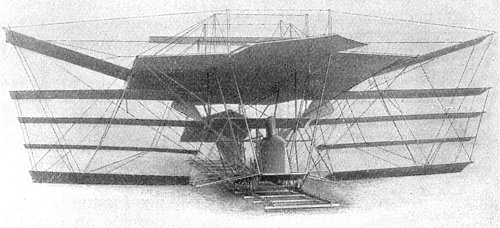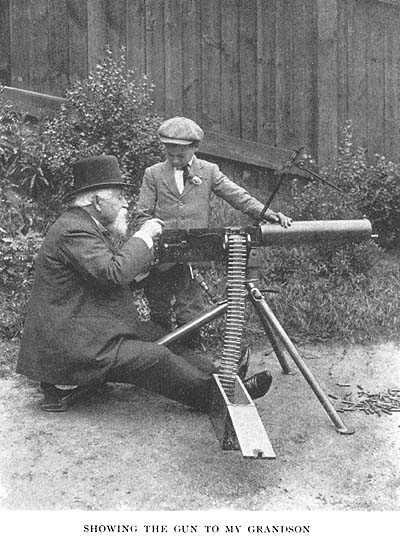Maxim's Airplane
Today, two early not-quite-airplanes. The University of Houston's College of Engineering presents this series about the machines that make our civilization run, and the people whose ingenuity created them.
The name Maxim keeps coming at you when you study the history of technology. Hudson and Hiram Maxim were actually two people -- brothers born in Maine in 1840 and 1853. The younger brother, Hudson, developed military explosives. Older brother Hiram was best known for his machine gun, but he invented all kinds of things -- explosives included. He worked for much of his life in England, and he was knighted for his work.
Now we find an article in the 1918 Journal of the Society of Automotive Engineers. It begins with two startling sentences:
The first power[ed] flight of an Airplane was not, as many suppose, that made by Ader in France in 1897. [It was made in] the large steam-powered machine designed and built by Sir Hiram Maxim.
Well, how many people know about Ader's and Maxim's airplanes today? Yet both airplanes were built, and both got off the ground.
The French builder, Clément Ader, made two wild bat-winged machines, powered by steam engines. In 1890, the first one got a few inches into the air and skimmed the ground for fifty yards. But it had a design flaw that didn't show up in that minimal flight. Ader hadn't provided adequate control. Still, he thought he'd succeeded and immediately began a larger version. When he flew it in 1897, it barely got off the ground and then crashed.
Maxim invested £20,000 in building a huge, hundred-foot-wingspan, multi-winged machine, in England. It was powered by two lightweight 180-horsepower steam engines that he'd designed for it. Maxim began flight tests in 1894. On the third try the plane was powered up to forty miles per hour, left its track, flew two hundred feet, and crashed. After that, Maxim lost interest in flying. He went on to other inventions.
Three years before, he'd written an article that began with a critical look at French attempts to build dirigibles. That was a clumsy form of flight, he said. A bird weighs six hundred times more than the air it displaces; yet a goose, for example, never exerts more than a tenth of a horsepower in flight.
Maxim never doubted that heavier-than-air flight would win out. He also noted that birds could combine lift and propulsion in their wings, but that was too subtle for us. And we didn't manage to do so until the late 1930s, when we finally created helicopters.
Finally, unlike the Wright brothers, Maxim had a morbid certainty about the purpose of the airplane. He ends his 1891 article thus:
Flying-machines will therefore be employed only by the rich and highly civilized nations. Small nations and half-civilized tribes will still have to content themselves with their present mode of warfare.
Maxim may not have succeeded in flying; but, by 1915, airplanes were indeed flying the skies of France. And mounted upon them were the murderous kin of Maxim's machine guns.
I'm John Lienhard, at the University of Houston, where we're interested in the way inventive minds work.
(Theme music)
E. W. Roberts, Early Flight. Journal of the Society of Automotive Engineers., Vol. II, No. 4, 1918.
H. S. Maxim, My Life. (London: Methuen & Co., Ltd., 1915)
I. Hogg, The Weapons that Changed the World. (New York: Arbor House, 1986).
H. S. Maxim, A New Flying-Machine: Maxim's Experiments in Aerial Navigation. The Century Magazine, Vol. XLIV, No. 3, January 1895, pp. 444-456.
H. S. Maxim, Aerial Navigation: The Power Required. The Century Magazine Vol. XLII, No. 6, October, 1891, pp. 829-836.
For more on Hiram Maxim, see Episodes 694 and 1357.
This is a greatly revised version of Episode 210.

Photograph of Maxim's flying machine taken on its launch rails in 1893.
(From the 1895 Century Magazine)

Chilling image of Maxim showing his gun off to his grandson
(from My Life, 1915)